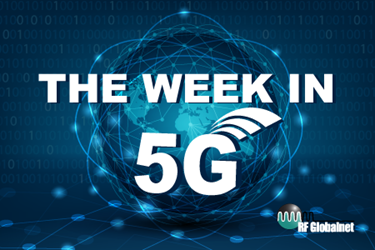The Week In 5G: 3/5/2019 – Dell Sees 5G Rollouts In Targeted Use Cases, Trump Campaign And White House Flub 5G Strategy Messaging
By Jof Enriquez,
Follow me on Twitter @jofenriq

Niche, yet fully commercialized use cases, will characterize most nascent 5G rollouts, according to Dell EMC CTO John Roese. He predicts that applications such as home broadband, Internet of Things (IoT), autonomous vehicles, and industrial automation, among others, initially will utilize 5G independently, before becoming more interconnected as 5G networks become more robust and widespread around 2021 or 2022.
“It takes a while for these networks to propagate,” Roese said during a keynote speech at MWC 2019 in Barcelona.
Roese added, “Delivering a geo-scale cellular infrastructure is not a three-month exercise. But I do think the next two years, we’re not just going to see ‘kick the tires’ — we’re going to see geofenced, fairly specific use cases where this idea of high-bandwidth, low-latency, edge compute-driven, cloud-oriented mobility makes a lot of sense and we can constrain the problem space to areas where that demand exists and can be deployed and put into production. I think by 2022, we’ll have enough of this deployed in the general sense, where more of the consumer and commercial applications become legitimately deployable,” reported RCR Wireless.
U.S. carrier Sprint this week called out AT&T and Verizon's strategy to limit their 5G rollouts "in a fixed environment in a very small portion of a city," reported CRN. Sprint's 5G strategy is broad-based and will target enterprise clients by pushing its network of sales channels to sell 5G IoT products to this segment.
CRN reported that Sprint is offering purpose-built IoT solutions for the channel, including its Sprint IoT-in-a-box offering, an industry-specific monitoring solution that includes a gateway and sensors that can be applied in a variety of use cases, such as education and health care.
Other specific use cases in agriculture, tourism, renewable energy and fashion also are being developed. CBR reported that the United Kingdom even released this week a 5G "connected cows" application, meant to drum up interest in agricultural technology and help commercial farms increase profitability.
Nokia CTO Marcus Weldon told ZDNet at MWC that it "would be "years-ish" before telcos begin to see revenue from enterprise 5G — but when they do, Weldon predicted the revenue will equal the amount being made in the consumer 5G mobile space.
Weldon said the "hyper competitive" mobile market and the economics of fixed-wireless 5G over fiber fixed-line access have driven demand for Nokia's 5G fixed-wireless access solutions — such as its FastMile 5G indoor gateway — for carriers conducting hundreds of trials in Japan, Australia, Canada, and the United States. Moreover, 5G fixed-wireless reportedly has become more viable with the advent of Massive MIMO and beam-forming technology, as well as the addition of millimeter-wave (mmWave) spectrum.
Through a wide-ranging partnership, Nokia is helping Korean mobile operator KT launch nationwide 5G service this month in 24 Korean cities, expressways, subways, railways, universities, and shopping areas, reported Telecoms.com. This is an expansion of the synchronized but limited launch of 5G services by telcos KT, LG U+, and SKT on Dec. 1, 2018.
KT is focusing on five key areas to deploy 5G: smart cities, smart factories, connected cars, 5G media, and the 5G cloud. This strategy is aligned with Nokia's vision that vertical 5G applications in the enterprise and public sectors will yield substantial money for carriers in the next few years. KT projects that 5G will contribute to 1.5 percent of South Korea’s GDP by 2025. An analysis by Arthur D. Little (ADL) puts Korea in the lead in 5G deployment, ahead of the U.S., in terms of technical infrastructure and 5G commercialization.
In line with America's aim to be first in 5G, the White House has advocated for the private sector to take the lead in 5G deployment in America. However, according to Politico, the 'Trump 2020' presidential campaign this week revived a plan for a nationalized, "wholesale" 5G network, which would see either the government or a single appointed entity oversee a sharing system of spectrum among wireless providers.
Current policy is industry-driven, whereby carriers like AT&T, Verizon, T-Mobile, and Sprint buy chunks of spectrum from the Federal Communications Commission (FCC) to build their 5G networks.
However, after reportedly receiving blowback from key Trump administration officials — such as White House economic adviser Larry Kudlow, and FCC officials — the campaign clarified its stance on the issue.
“The White House sets the policy on 5G and all issues,” campaign spokesperson Kayleigh McEnany stated, as reported by Axios. “Naturally, the campaign fully supports the President’s priorities and his policy agenda. There is no daylight between the White House and the campaign.”
Related, AT&T will test up to ten prototype devices (user equipment) that will operate under 24 GHz mmWave spectrum, according to Light Reading. The testing in Austin, Texas, was applied for on February 20, 2019, ahead of the first 24 GHz 5G auction by FCC on March 14. The agency completed its 28 GHz 5G auction on January 24, when AT&T, Verizon and T-Mobile placed bids.
As one Forbes contributor put it, "5G is probably the biggest leap forward in terms of the life-changing nature of mobile tech," and MWC 2019 provided the latest venue for phone manufacturers to showcase their upcoming 5G phones, desktops and laptops.
CNET, however, points out that "there's only so much downloading and streaming we'll all do when we get our 5G phones," and that there are no "killer apps" yet to justify shelling out hundreds of dollars more to get a 5G phone.
Also, carriers are being cautious with their investments, since they need to spend $160 billion yearly to roll out 5G networks around the world, according to an estimate by GSMA, and it’s going to take a few years before 5G connectivity starts to become ubiquitous, reported Venture Beat.
